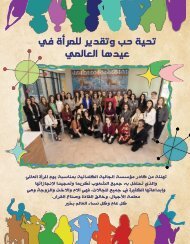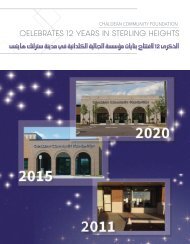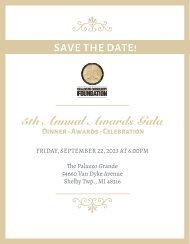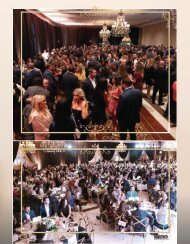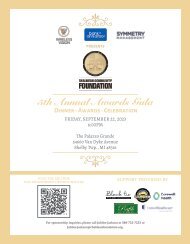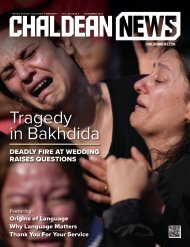MARCH 2008
cn0308_0172
cn0308_0172
Create successful ePaper yourself
Turn your PDF publications into a flip-book with our unique Google optimized e-Paper software.
let’s halhole!<br />
Younger generation embraces tradition<br />
BY JOYCE WISWELL<br />
PHOTO BY WILSON SARKIS<br />
When Avita Bacall<br />
got married a year<br />
and a half ago, her<br />
grandmother let<br />
loose with a giant trill – better<br />
known to members of the<br />
Chaldean community as the<br />
halhole.<br />
“She said, ‘I can’t help<br />
myself, it comes from the heart.<br />
It’s an overcoming of joy,’”<br />
recalled Bacall, 24, of<br />
Waterford.<br />
Bacall didn’t mind – in fact,<br />
she loves the halhole, that<br />
shrill, high-pitched sound of<br />
happiness women make (which<br />
usually startles any non-<br />
Chaldeans in attendance).<br />
“It is used to celebrate<br />
happy occasions,” said<br />
Josephine Sarafa, executive<br />
director of the Chaldean<br />
Cultural Center. “At funerals,<br />
it’s more of a wailing sound.”<br />
The halhole, which many<br />
learn as young girls from their<br />
mothers, grandmothers and<br />
aunts, started to die out locally<br />
in the 1950s as immigrants<br />
embraced American ways. But<br />
since the mid-1960s, the halhole<br />
has reemerged as a<br />
favorite wedding tradition,<br />
Sarafa said.<br />
“After 1965 when thousands<br />
of Chaldeans came from<br />
Iraq all the old traditions were<br />
reinforced by the newcomers,”<br />
she said. “It has become a<br />
resurgent tradition.”<br />
Nadine Rabban, 56, said she<br />
wishes she’d learned the sound<br />
as a girl. “My mother and aunt<br />
did it at my wedding 22 years<br />
ago but I never learned,” said<br />
the Novi resident. “Now my<br />
daughters try it. It’s a great tradition<br />
and if I had learned it when<br />
I was younger, I would do it.”<br />
Younger generations are also<br />
Alia Shango is feted by a zeffa band as she leaves her parents’ home.<br />
starting to embrace other traditions<br />
from Iraq, Sarafa said,<br />
including a henna party and<br />
the throwing of sweets onto<br />
the bride. Bacall’s wedding day<br />
featured the tabul (drum) and<br />
zarna (flute).<br />
“The groom’s mom and other<br />
females come and literally take<br />
the bride from her home,”<br />
Bacall said. “I loved it, and it<br />
sparked a lot of emotions of<br />
back home with my grandparents<br />
and my dad.”<br />
Margueritte Esshaki of Cass<br />
Lake is one of the community’s<br />
best-known halholers. “I have<br />
good breath,” said the 70-yearold.<br />
“I can go for a long time<br />
and do it very high.”<br />
Esshaki wins prizes at bridal<br />
showers for her trilling skills,<br />
but said she refrains at weddings.<br />
“With the men<br />
there, it’s a little different,”<br />
she admitted.<br />
Some church leaders<br />
are asking women to<br />
refrain from the halhole<br />
during marriage ceremonies,<br />
saying it’s<br />
become too competitive<br />
of who can do it the<br />
loudest or longest.<br />
“Do it outside all you<br />
want, but don’t cut off<br />
the prayers,” said Fr.<br />
Frank Kalabat of St.<br />
Thomas. “Keep a serene<br />
and prayerful atmosphere<br />
in the church.”<br />
Rather than forbid it<br />
outright, Fr. Kalabat asks celebrants<br />
to wait until the couple is<br />
introduced as husband and wife.<br />
“Then you can take out your<br />
frustration,” he laughed, “and<br />
let all that pent-up halhole<br />
out.”<br />
the wedding guide<br />
“GIVE ALL TO LOVE; OBEY THY HEART.”<br />
– RALPH WALDO EMERSON<br />
<strong>MARCH</strong> <strong>2008</strong> CHALDEAN NEWS 31




